#would love to see asterix and his friends explore other parts of the ancient world
Text
Anonymous asked: I noticed you did post to acknowledge the death of Uderzo, the co-creator of the Asterix comics. I have to ask Tintin or Asterix? Which one do you prefer?
It’s like asking Stones or Beatles? I love both but for different reasons. I would hate to choose between the two.
Both Tintin and Asterix were the two halves of a comic dyad of my childhood. Whether it was India, China, Hong Kong, Japan, or the Middle East the one thing that threads my childhood experience of living in these countries was finding a quiet place in the home to get lost reading Asterix and Tintin.
Even when I was eventually carted off to boarding school back in England I took as many of my Tintin and Asterix comics books with me as I could. They became like underground black market currency to exchange with other girls for other things like food or chocolates sent by parents and other illicit things like alcohol. Having them and reading them was like having familiar friends close by to make you feel less lonely in new surroundings and survive the bear pit of other girls living together.
If you asked my parents - especially my father - he would say Tintin hands down. He has - and continues to have in his library at home - a huge collection of Tintin comic books in as many different language translations as possible. He’s still collecting translations of each of the Tintin books in the most obscure languages he can find. I have both all the Tintin comic books - but only in English and French translations, and the odd Norwegian one - as well as all the Asterix comic books (only in English and French).
Speaking for myself I would be torn to decide between the two. Each have their virtues and I appreciate them for different reasons.
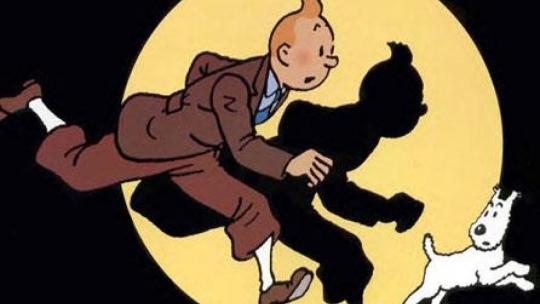
Tintin was truly about adventure that spoke deeply to me. Tintin was always a good detective story that soon turned to a travel adventure. It has it all: technology, politics, science and history. Of course the art is more simpler, but it is also cleaner and translates the wondrous far-off locations beautifully and with a sense of awe that you don’t see in the Asterix books. Indeed Hergé was into film-noir and thriller movies, and the panels are almost like storyboards for The Maltese Falcon or African Queen.
The plot lines of Tintin are intriguing rather than overly clever but the gallery of characters are much deeper, more flawed and morally ambiguous. Take Captain Haddock I loved his pullover, his strangely large feet, his endless swearing and his inability to pass a bottle without emptying it. He combined bravery and helplessness in a manner I found irresistible.
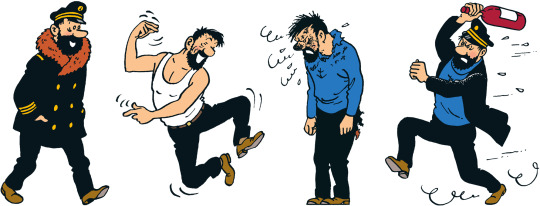
I’ve read that there is a deeply Freudian reading to the Tintin books. I think there is a good case for it. The Secret of the Unicorn and Red Rackham's Treasure are both about Captain Haddock's family. Haddock's ancestor, Sir Francis Haddock, is the illegitimate son of the French Sun King – and this mirrors what happened in Hergé's family, who liked to believe that his father was the illegitimate son of the Belgian king. This theme played out in so many of the books. In The Castafiore Emerald, the opera singer sings the jewel song from Faust, which is about a lowly woman banged up by a nobleman – and she sings it right in front of Sir Francis Haddock, with the captain blocking his ears. It's like the Finnegans Wake of the cartoon. Nothing happens - but everything happens.
Another great part is that the storylines continue on for several albums, allowing them to be more complex, instead of the more simplistic Asterix plot lines which are always wrapped up nicely at the end of each book.

Overall I felt a great affinity with Tintin - his youthful innocence, wanting to solve problems, always resourceful, optimistic, and brave. Above all Tintin gave me wanderlust. Was there a place he and Milou (Snowy) didn’t go to? When they had covered the four corners of the world Tintin and Milou went to the moon for heaven’s sake!
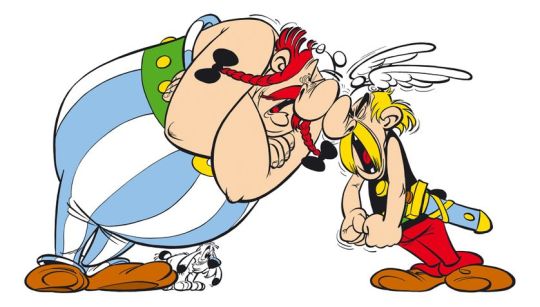
What I loved about Asterix was the style, specifically Uderzo’s visual style. I liked Hergé’s clean style, the ligne claire of his pen, but Asterix was drawn as caricature: the big noses, the huge bellies, often being prodded by sausage-like fingers. This was more appealing to little children because they were more fun to marvel at.
In particular I liked was the way Uderzo’s style progressed with each comic book. The panels of Asterix the Gaul felt rudimentary compared to the later works and by the time Asterix and Cleopatra, the sixth book to be published, came out, you finally felt that this was what they ought to look like. It was an important lesson for a child to learn: that you could get better at what you did over time. Each book seemed to have its own palette and perhaps Uderzo’s best work is in Asterix in Spain.
I also feel Asterix doesn’t get enough credit for being more complex. Once you peel back the initial layers, Asterix has some great literal depth going on - puns and word play, the English translation names are all extremely clever, there are many hidden details in the superb art to explore that you will quite often miss when you initially read it and in a lot of the truly classic albums they are satirising a real life country/group/person/political system, usually in an incredibly clever and humorous way.
What I found especially appealing was that it was also a brilliant microcosm of many classical studies subjects - ancient Egypt, the Romans and Greek art - and is a good first step for young children wanting to explore that stuff before studying it at school.
What I discovered recently was that Uderzo was colour blind which explains why he much preferred the clear line to any hint of shade, and it was that that enabled his drawings to redefine antiquity so distinctively in his own terms. For decades after the death of René Goscinny in 1977, Uderzo provided a living link to the golden age of the greatest series of comic books ever written: Paul McCartney to Goscinny’s John Lennon. Uderzo, as the Asterix illustrator, was better able to continue the series after Goscinny’s death than Goscinny would have been had Uderzo had died first, and yet the later books were, so almost every fan agrees, not a patch on the originals: very much Wings to the Beatles. What elevated the cartoons, brilliant though they were, to the level of genius was the quality of the scripts that inspired them. Again and again, in illustration after illustration, the visual humour depends for its full force on the accompaniment provided by Goscinny’s jokes.
Here below is a great example:
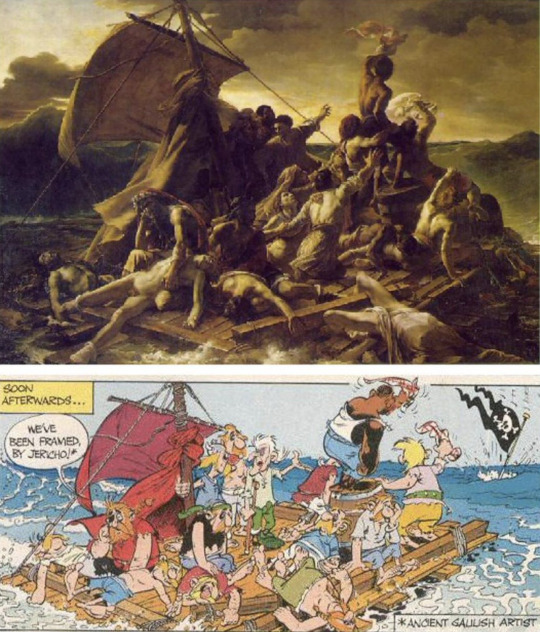
There’s a lot of genius in this. Uderzo copied Theodore Géricault’s iconic ‘Raft of the Medusa’ 1818 painting in ‘Asterix The Legionary’. The painting is generally regarded as an icon of Romanticism. It depicts an event whose human and political aspects greatly interested Géricault: the wreck of a French frigate, Medusa, off the coast of Senegal in 1816, with over 150 soldiers on board. But Anthea Bell’s translation of Goscinny’s text (including the pictorial and verbal pun ‘we’ve been framed, by Jericho’) is really extraordinary and captures the spirit of the Asterix cartoons perfectly.
This captures perfectly my sense of humour as it acknowledges the seriousness of life but finds humour in them through a sly cleverness and always with a open hearted joy. There is no question that if humour was the measuring yard stick then Asterix and not Tintin would win hands down.
It’s also a mistake to think that the world of Asterix was insular in comparison to the amazing countries Tintin had adventures. Asterix’s world is very much Europe.
Every nationality that Asterix encounters is gently satirised. No other post-war artistic duo offered Europeans a more universally popular portrait of themselves, perhaps, than did Goscinny and Uderzo. The stereotypes with which he made such affectionate play in his cartoons – the haughty Spaniard, the chocolate-loving Belgian, the stiff-upper-lipped Briton – seemed to be just what a continent left prostrate by war and nationalism were secretly craving. Many shrewd commentators believe that during the golden age when Goscinny was still alive to pen the scripts, that it was a fantasy on French resistance during occupation by Nazi Germany. Uderzo lived through the occupation and so there is truth in that. Perhaps this is why the Germans are the exceptions as they are treated unsympathetically in Asterix and the Goths, and why quite a few of the books turn on questions of loyalty and treachery.

Even the British are satirised with an affection that borders on love: the worst of the digs are about our appalling cuisine (everything is boiled, and served with mint sauce, and the beer is warm), but everything points to the Gauls’ and the Britons’ closeness. They have the same social structure, even down to having one village still holding out against the Romans; the crucial and extremely generous difference being that the Britons do not have a magic potion to help them fight. Instead they have tea, introduced to them by Getafix, via Asterix, which gives them so much of a psychological boost that it may as well have been the magic potion.

I re-read ‘Asterix in Britain’ (Astérix chez les Bretons) in the light of the 2016 Brexit referendum result and felt despaired that such a playful and respectful portrayal of this country was not reciprocated. Don’t get me wrong I voted for Brexit but I remain a staunch Europhile. It made me violently irritated to see many historically illiterate pro-Brexit oiks who mistakenly believed the EU and Europe were the same thing. They are not. One was originally a sincere band aid to heal and bring together two of the greatest warring powers in continental Europe that grotesquely grew into an unaccountable bureaucratic manager’s utopian wet dream, and the other is a cradle of Western achievement in culture, sciences and the arts that we are all heirs to.
What I loved about Asterix was that it cut across generations. As a young girl I often retreated into my imaginary world of Asterix where our family home had an imaginary timber fence and a dry moat to keep the world (or the Romans) out. I think this was partly because my parents were so busy as many friends and outsiders made demands on their time and they couldn’t say no or they were throwing lavish parties for their guests. Family time was sacred to us all but I felt especially miffed if our time got eaten away. Then, as I grew up, different levels of reading opened up to me apart from the humour in the names, the plays on words, and the illustrations. There is something about the notion of one tiny little village, where everybody knows each other, trying to hold off the dark forces of the rest of the world. Being the underdog, up against everyone, but with a sense of humour and having fun, really resonated with my child's eye view of the world.
The thing about both Asterix and Tintin books is that they are at heart adventure comics with many layers of detail and themes built into them. For children, Asterix books are the clear winner, as they have much better art and are more fantastical. Most of the bad characters in the books are not truly evil either and no-one ever dies, which appeals hugely to children. For older readers, Tintin has danger, deeper characters with deep political themes, bad guys with truly evil motives, and even deaths. It’s more rooted in the real world, so a young reader can visualise themselves as Tintin, travelling to these real life places and being a hero.
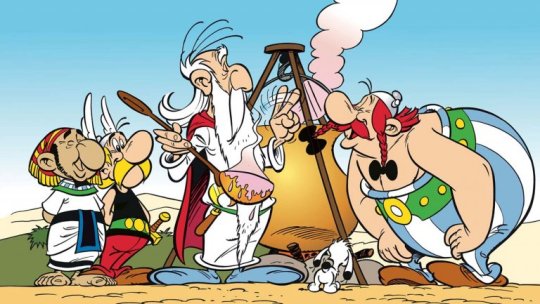
As I get older and re-read Asterix and Tintin from time to time I discover new things.
From Asterix, there is something about the notion of one tiny little village, where everybody knows each other, trying to hold off the dark forces of the rest of the world. Being the underdog, up against everyone, but with a sense of humour and having fun, really resonated with my child's eye view of the world. In my adult world it now makes me appreciate the value of family, friends, and community and even national identity. Even as globalisation and the rise of homogenous consumerism threatens to envelope the unique diversity of our cultures, like Asterix, we can defend to the death the cultural values that define us but not through isolation or by diminishing the respect due to other cultures and their cultural achievements.

From Tintin I got wanderlust. This fierce even urgent need to travel and explore the world was in part due to reading the adventures of Tintin. It was by living in such diverse cultures overseas and trying to get under the skin of those cultures by learning their languages and respecting their customs that I realised how much I valued my own heritage and traditions without diminishing anyone else.
So I’m sorry but I can’t choose one over the other, I need both Asterix and Tintin as a dyad to remind me that the importance of home and heritage is best done through travel and adventure elsewhere.
Thanks for your question.
298 notes
·
View notes